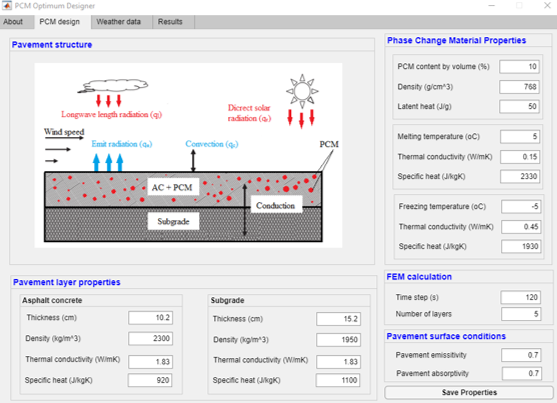Micro-Encapsulated Phase Change Material
This study focuses on using the latent heat of phase change materials to enhance the low-temperature performance of asphalt mixtures and delay the formation of black ice. The author utilized the micro-encapsulation method to create micro-encapsulated phase change materials that retained the latent heat effect while improving their thermal resistance at high mixing temperatures. The author developed a numerical heat transfer model using the enthalpy method to investigate the effect of phase change materials in asphalt pavements. They also created a phase change material designer program to design the optimum phase change material for delaying black ice formation. The author evaluated the properties of micro-encapsulated phase change materials using Scanning Electron Microscope, Differential Scanning Calorimetry, and Thermal Gravimetry tests. They also conducted laboratory tests to examine the effect of phase change materials on asphalt binder and asphalt mixture, including dynamic shear rheometer, low-temperature sweep, Hamburg wheel tracking, fatigue loading, and thermal conductivity tests. Finally, the author assessed the impact of micro-encapsulated phase change materials on temperature regulation and black ice delaying by exposing asphalt concrete slabs to environmental conditions.

Article 1
Tam M. Phan et al., . “Simulation on heat transfer of phase change material modified asphalt concrete for delaying black ice formation”
This study aims to determine the type (e.g., melting point, freezing point, latent heat fusion) and optimal content of phase change material (PCM) based on the numerical and experimental analyses evaluating the effects of heat transfer in PCM-modified asphalt pavement systems. The effect of PCM on the thermophysical properties of PCM-modified asphalt concrete can be taken as an effective volumetric heat capacity. The volumetric fraction of PCM was calculated using an iterative method. The numerical model was established and computed using the MATLAB 2020 software. The optimum PCM design tool was developed to select the type and contents of the PCM. The PCM was chosen based on the following criteria: black-ice-formation delay time, minimize temperature increase, and increase temperature area. To validate the numerical model, asphalt mixtures were modified with varying PCM contents, and the temperature response of the PCMmodified asphalt samples was examined via temperature test.
Article 2
Tam M. Phan et al., . “Improvement on rheological property of asphalt binder using synthesized micro-encapsulation phase change material”
Temperature is a governing parameter that affects the rheological property of asphalt binder. Upon cooling, bitumen becomes stiffer and prone to thermal cracking. To reduce the negative impact of temperature, utilizing the thermal energy storage of phase change material is a promising solution. This study provides an approach to synthesize micro-encapsulation phase change material (μPCM) and its application to enhance the binder’s rheological property and mitigate black ice. Two μPCMs were prepared with n-Tetradecane as a core, while Calcium carbonate (CaCO3) and Silicate (SiO2) as a shell. SEM test exhibited that μPCM had a spherical shape with a diameter ranging from 1 to 7 μm. Meanwhile, thermogravimetric analysis proved that the encapsulation method could protect and prevent leakage of n-Tetradecane under high temperature. The residual weight of CaCO3-μPCM was 95% and 84% at 160 °C and 350 °C, respectively. The differential scanning calorimeter results showed that the encapsulation ratio was approximately 52.9% (ΔH = 99.94 W/g). Moreover, different μPCM modified asphalt binders were examined to evaluate the rheological property. Results from rotational viscosity test at 135 °C pointed out that adding μPCM did not affect binder viscosity. DSR test showed that the incorporation of μPCM could reduce binder stiffness at low temperatures. The thermal effect of μPCM was analyzed by low-temperature sweep test. With simultaneous cooling, μPCM released latent heat, thus increasing the binder’s temperature by 1.5 °C. The low values of Gsinδ indicated the outperformance of μPCM-binder compared to conventional binder in terms of thermal cracking resistance.
Article 3
Tam M. Phan et al., . “Utilization of micro encapsulated phase change material in asphalt concrete for improving low-temperature properties and delaying black ice”
Once black ice happens, it strongly reduces the friction of the tire-road surface, resulting in dangerous driving and reducing the performance of asphalt mixture. This study aims to utilize latent heat fusion during phase transition of micro encapsulated phase change material (μPCM) to improve low-temperature performances and delay black ice formation. The properties of asphalt mixture were carried out by several laboratory experiments. Asphalt slabs with μPCM additives were exposed to outdoor winter environment to evaluate the effect of μPCM on temperature regulation. Furthermore, a comparison was studied between fresh and 6-month-old μPCM slabs to investigate the effectivity of μPCM latent heat release. Indirect tensile asphalt cracking results showed that containing 1.5% μPCM (weight of mixture) could increase cracking tolerance index and indirect tensile strength at low temperature (4 °C). Fatigue loading test concluded that all μPCM modified asphalt mixtures are within normally accepted performance, while monotonic loading test indicated that the addition of an appropriate μPCM could improve reflection cracking resistance at low temperature. The presence of μPCM could mitigate low temperature cracking damage by decreasing stiffness and increasing phase angle of asphalt mixture. Besides, the monitored temperature showed that μPCM modified mixture acquired 2 °C higher compared to conventional mixture. The delay freezing was approximately 1 h and 10 min, which may benefit in delay black ice formation. After six months exposed to outdoor conditions, the latent heat fusion of μPCM was still present. Finally, the utilization of μPCM is a promising solution to improve low temperature cracking resistance and delaying black ice formation.
